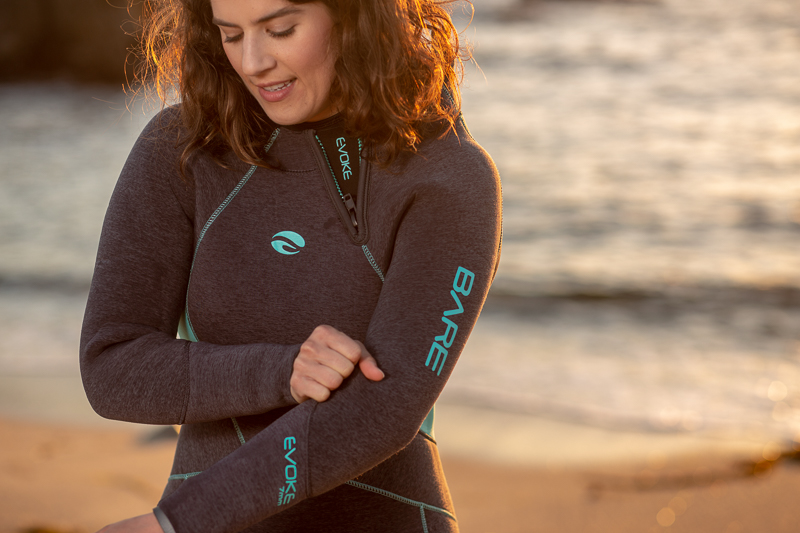Putting on a wetsuit can be a nightmare. Violent pulling, rolling the foot ring slowly around your ankle, asking a stranger to zip you up—we’ve all been there. But on the contrary, sometimes, when conditions—and fit—are just right, donning a piece of neoprene can be a quick and easy experience.
This juxtaposition, between ease and struggle, is why it’s so important to find the right wetsuit for your body and the type of activities you’ll be doing most often.
What temperatures do you need it for?
Something to keep in mind: The average water temps where you will be using the suit largely dictate the thickness and style necessary for your day-to-day use. If you’re cold-water diving on the western fringes of Puget Sound, you’re best off having something within range of 7mm, like the Men’s BARE Reactive.
But if you’ll be using it to dive in Thailand during the month of April, it’s probably a safe bet to have a suit in the 2-3mm range, like the women’s BARE Elate.
Don’t go too big, or too small
For a wetsuit to function properly, it’s essential that it fits correctly to your body. If there’s too much excess room in the crotch and armpits, it’ll allow water to build up in those areas and deplete the warmth and effectiveness of the suit.
Megan Ehrenberg, technical diver and Director of Marketing at Duck Diver Marketing and a self-professed gear junkie, says that a well-fitting wetsuit should feel snug above the water. “You want it snug and to have a thin layer of water [inside] to warm up—and keep you warm.”
Finding a suit with the proper length, Ehrenberg says, is also essential. Wrist and ankle rings should seal firmly and not easily permit inflow and outflow of water. If a suit is too long, it’s ankle and wrist won’t seal effectively and allow the flushing of water, which will prevent your body’s thermal heating of the suit. Long story short: You’ll get cold.
But going with a wetsuit that’s too small is also a big mistake. “You should be able to have full mobility,” Ehrenberg emphasizes. “If it’s too small or too short, it will pull on your neck and shoulders, causing major fatigue.”
Skip the rashguard (most of the time)
It’s long been assumed that rash guards create additional insulation when layered under neoprene, but that’s almost never the case. More often, a rash guard prevents productive sealing between your skin and the wetsuit, which ensures more flushing and a greater amount of inflow and outflow. Again, for best results, choose the appropriate millimeter density for the type of water you’ll be in and trust your wetsuit.
However, rashguards do provide great sun protection and light insulation if you’re snorkelling, surfing and/or boating in warmer climates and water conditions.
What activity?
BARE suits are built and engineered for aquatic exploration, many incorporating knee pads and other durability features that aim to make your experience more safe and enjoyable.
But when choosing a wetsuit, it’s important to be mindful of what type of activity you’ll be using it for. Few things feel worse than wearing a 7mm wetsuit on a hot day in the tropics. And vice-versa, committing to a dive in a 3-4mm suit only to find yourself shivering 20 meters below the surface can also be miserable. Generally, any suit that’s overbuilt—or underbuilt—for the conditions you find yourself in will not perform the way you want it to. So, know ahead of time what you’re likely to be getting into.
Will you be on a SUP all day? Going on a rafting trip? Consider an ExoWear full suit or combination of ExoWear accessories or a sleeveless wetsuit—a farmer John—that allows you to paddle more comfortably, and without chafing. But by all means, if the conditions call for a burly wetsuit—like diving in Lake Tahoe, Monterrey or Maine—plan and gear up accordingly in something thick, like the BARE Reactive.
Avoid the struggle
Hopefully, you will use your suit a lot. But if the suit you choose is difficult to get in and out of, your diving, surfing, etc. rig-up won’t come with the same amount of joy. Bottom line: You won’t be stoked to put the suit on. And nobody wants that.
Prevent this dynamic by finding the right suit for you. Try to go to your local shop and try some on. If you hate pulling your feet and hands through too-tight ankle/wrist rings, try to find a suit that has zippered features that make suiting up easier and more enjoyable. At the end of the day, the best suit is the one you wear all the time and enjoy consistently, so take your time to find the perfect one for you and your passions











